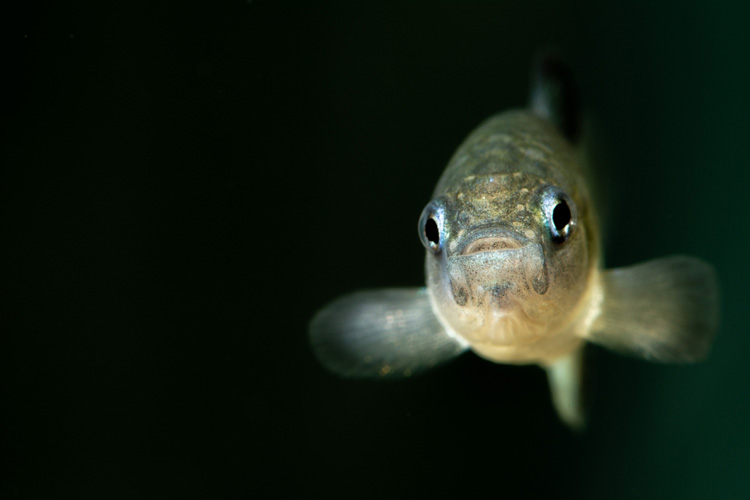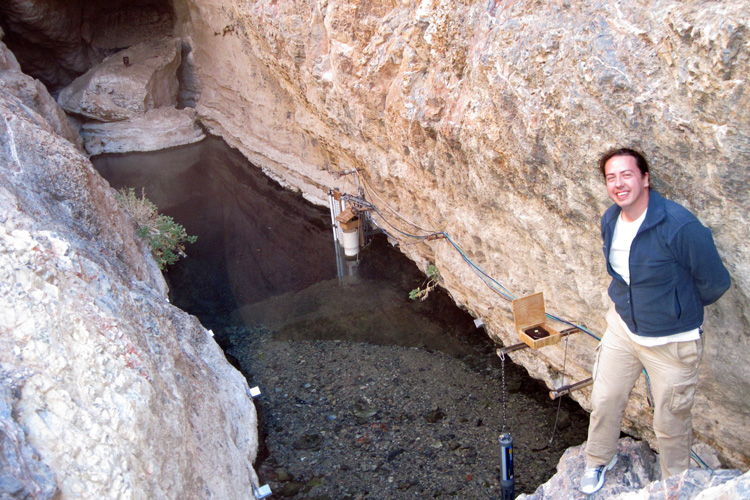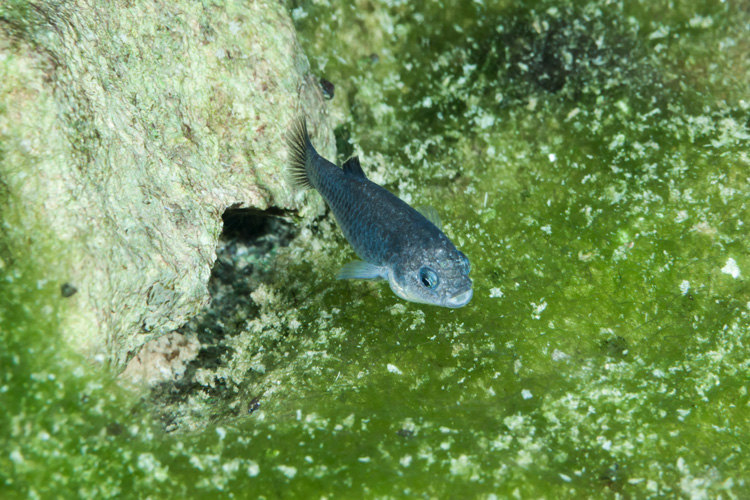Endangered Devils Hole Pupfish Is One of the Most Inbred Animals Known

As its name implies, the Devil’s Hole pupfish lives in a truly hellish environment.
Confined to a single deep limestone cave in Nevada’s Mojave Desert, 263 of them live in water that hovers around 93 degrees Fahrenheit year-round, with food resources so scarce that they are always on the edge of starvation, and with oxygen levels so low that most other fish would die immediately. The pupfish, Cyprinodon diabolis, live in the smallest habitat of any known vertebrate.
New research now documents the extreme effect that these harsh and isolated conditions have had on this fish’s genetic diversity.
In a paper published this week in the journal Proceedings of the Royal Society B, University of California, Berkeley, biologists report the first complete genome sequences of eight pupfish species from the American Southwest — 30 individuals in all, including eight Devils Hole pupfish. Astoundingly, the Devils Hole pupfish is so inbred that 58% of the genomes of these eight individuals are identical, on average.
“High levels of inbreeding are associated with a higher risk of extinction, and the inbreeding in the Devils Hole pupfish is equal to or more severe than levels reported so far in other isolated natural populations, such as the Isle Royale wolves in Michigan, mountain gorillas in Africa and Indian tigers,” said lead researcher Christopher Martin, UC Berkeley associate professor of integrative biology and curator of ichthyology in the campus’s Museum of Vertebrate Zoology. “Although we were not able to directly measure fitness, the increased inbreeding in these pupfish likely results in a substantial reduction in fitness.”
Other pupfish species are also inbred, the researchers found, but only between 10% and 30% of their genomes are identical.

Graduate student David Tian, lead author of the study, said that the level of inbreeding in the Devils Hole pupfish is equivalent to what would happen if four to five generations of siblings mated with one another. This tends to burn in or fix, rather than weed out, harmful mutations, potentially dooming a population to extinction by mutational meltdown. The Devils Hole pupfish species is currently doing well in the wild and in captive or “refuge” populations, but such low genetic diversity could spell trouble as the climate changes and human impacts become greater.
In the face of these potential threats, the new genome sequences will help scientists and conservationists assess the health of native pupfish populations and potentially intervene in refuge populations to increase the genetic diversity of these species — the Devils Hole pupfish, in particular.
“With this new genomic data, there’s a lot of potential to look not just at genetic diversity and how these species are related to each other phylogenetically, but also look at inbreeding and mutation load to get an idea of what their current status is, how evolutionary history may have influenced their current genetic variation, and think about where the population is going and what we should do, if anything, to preserve these species,” Tian said.
Population decline and rescue
Pupfish species are scattered around the globe and tend to like isolated lakes and springs, often with extreme conditions that most fish would find unsurvivable. About 30 species inhabit warm, salty desert springs and streams in California and Nevada. Martin has studied various pupfish populations, including several on San Salvador Island in the Bahamas, to understand the genetics behind their adaptation to extreme conditions and unusual ecological niches.

The Devils Hole pupfish, however, is unique in its small range and perilous existence, Martin said, making its fluctuating population in the wild worrisome to conservationists.
“Part of the question about these declines is whether they may be due to the genetic health of the population,” Martin said. “Maybe the declines are because there are harmful mutations that have become fixed because the population is so small.”
The small population is partly a result of human incursions into their habitat, Martin noted. Local ranchers and developers pumped groundwater in the region in the 1960s and ‘70s that drastically reduced the water level in Devils Hole, leading to a drop in population levels. A 1976 Supreme Court ruling that allowed the federal government to limit groundwater pumping saved Devils Hole and the resident population, while captive breeding at a nearby 100,000-gallon pool in the Ash Meadows National Wildlife Refuge rescued the species. Nevertheless, a decline in the 1990s led the wild population to its nadir in 2013: 35 individuals. The wild population has since recovered, while the refuge population has ballooned to about 400, twice the wild population.
Humans are not totally to blame for the lack of genetic diversity in the Devils Hole pupfish, however. The UC Berkeley researchers also sequenced the genome of a pupfish collected in 1980 and held at the University of Michigan. It showed inbreeding and a lack of genetic diversity similar to that found in individuals collected recently, most of which died a natural death. This implies that the pupfish has likely seen population bottlenecks frequently over hundreds, if not thousands, of years.
One result of this, Martin and Tian found, is that 15 genes have disappeared entirely from the Devils Hole pupfish genome. Five of them seem to be involved in adaptation to living in low-oxygen or hypoxic environments.

“These deletions are a paradox, because this is a habitat where you’re most exposed to hypoxia,” Martin said. “It could have something to do with the stability of the habitat over time. But it looks to us like the hypoxia pathway is broken. Once you break one gene, it doesn’t really matter if you break additional genes in that regulatory pathway. Our future work is to actually look at what these deletions do. Do they increase tolerance of hypoxia? Do they decrease tolerance of hypoxia? I think those two scenarios are equally plausible at this time.”
Selective breeding within a captive population of Devils Hole pupfish could help increase the diversity and perhaps save the species from eventual extinction, he said. And to restore genes already lost, CRISPR genome editing could add them back.
The fact that the genome of the fish collected in 1980 was about as inbred as today’s fish is “maybe good news,” Martin said, “in that the population has historically been highly inbred with very low genetic diversity, suggesting that the recent decline in the ‘90s, with population bottlenecks to only 35 fish in 2013 and 38 fish in 2007, doesn’t seem to have had much of an effect.”
Tian is currently analyzing about 150 complete genome sequences of nine species of American pupfish to get a more complete picture of the deleterious mutations and gene deletions in the various Southwestern populations. He sees the study as an example of what conservation genomics can do for endangered and possibly inbred populations around the world.
“We’re on a really cool cusp when it comes to using genomic data and applying it to conservation, especially at a time where it’s a problem that is likely only going to get worse with climate change and increased habitat fragmentation and just anthropogenic changes,” he said.
Tian is leery of genetic interventions, however, since little is known about how genes influence the physical and behavioral characteristics of a species and how this relates to fitness and adaptation to a specific environment. Conservation should still be a priority.
“The answer is still increased funding for these populations, protecting habitats, legal avenues for protecting these species and figuring out ways for humans and these endangered species to coexist on this planet,” he said.
Co-authors with Martin and Tian are Austin Patton of UC Berkeley and Bruce Turner of Virginia Tech in Blacksburg. The work is funded by the U.S. Fish and Wildlife Service, National Park Service, National Science Foundation (1749764) and National Institutes of Health (5R01DE027052-02).
